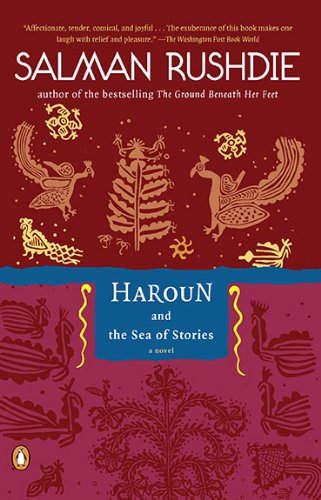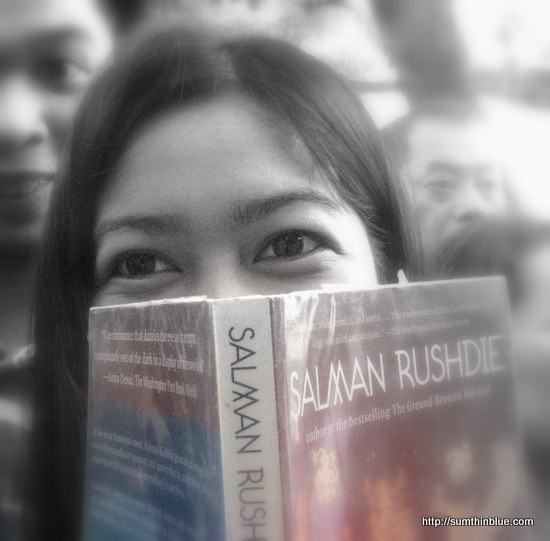
I’ve always wanted to try Salman Rushdie, so I included him in my list for the A-Z Challenge. I have a bunch of his books in my perpetually insurmountable TBR pile, and I’m falling behind in the challenge, so I resolved to pick up the pace so I can finish by the end of the year. Having not read any of Rushdie’s books before, I decided to go with Haroun and the Sea of Stories first, so I can take on his more complex works later on (maybe next year?).
Written in 1990, Haroun and the Sea of Stories was Rushdie’s first novel after his highly controversial Satanic Verses (earning him an Islamic death sentence and causing multiple deaths from violence related to the book). Told from the point of view of a young boy named Haroun, the novel is an allegorical children’s book dedicated to Rushdie’s son, Zafar.
 Haroun is the son of the famed storyteller Rashid Khalifa, known to his fans as “The Ocean of Notions” and his detractors as “The Shah of Blah.” As a professional storyteller, Rashid is often hired by politicos to tell captivating stories that would get crowds to vote for them. When Haroun asks Rashid where the stories come from, Rashid tells him he has a tap connected to the Sea of Stories.
Haroun is the son of the famed storyteller Rashid Khalifa, known to his fans as “The Ocean of Notions” and his detractors as “The Shah of Blah.” As a professional storyteller, Rashid is often hired by politicos to tell captivating stories that would get crowds to vote for them. When Haroun asks Rashid where the stories come from, Rashid tells him he has a tap connected to the Sea of Stories.
Haroun’s mother Soraya runs off with the neighbor Mr. Sengupta, and Haroun is traumatized. In an outburst, Haroun screams at Rashid, “What’s the use of stories that aren’t even true?” It is the question that Mr. Sengupta once put to Soraya, causing her marriage to Rashid to deteriorate, and hearing it from Haroun adds to Rashid’s devastation, robbing him of his storytelling abilities.
A water genie, Iff, comes to cut off Rashid’s supply of imagination from the Sea of Stories, and Haroun manages to stop him by stealing the genie’s disconnecting tool. Haroun uses the tool to blackmail Iff into taking him to the Sea of Stories to restore his father’s gift of storytelling.
The novel is outlandish and whimsical — much like Alice in Wonderland, Rashid is transported to a world of nonsense in the Story Moon, Kahani,and oddly enough, it all begins to make sense to him. The novel, which draws the spotlight on how storytelling is an essential part of human life, is layer upon layer of metafiction: what appears to be reality turns into a story within a story within a dream that turns out to be a story, or perhaps, reality — what a mixup! It constantly blurs the line between fiction and reality, and exposes binary opposites that turn out to not to be quite as disparate as they initially appear to be.
I also enjoyed the clever wordplay in the novel, like Haroun’s friends on Kahani being named Iff (the water genie) and Butt (the mechanical Hoopoe bird); and the Gup army, the “Library” — made up of the famous Pages (soldiers) of Gup, regimented into Chapters and then Volumes, with each Volume headed by a Front, or Title, Page!
The novel also appears to be an allegory to Rushdie’s experience as a writer, with references to censorship: “But what is the point of giving persons Freedom of Speech… if you then say they must not utilize same? And is not the Power of Speech the greatest Power of all? Then surely it must be exercised to the full?” and “Any story worth its salt can handle a little shaking up,” both remarks by Butt the Hoopoe. As this was Rushdie’s first novel after the Satanic Verses, many believe it also alludes to Rushdie’s personal struggle to recover his gift of storytelling.
I thorougly enjoyed my first Rushdie book. Maybe next year I’ll be ready for Midnight’s Children.
Haroun and the Sea of Stories, paperback, from Book Sale, 4/5 stars
Book #132 for 2010, R for the A-Z Challenge
*Cover photo: New York City Opera 2004 adaptation of Haroun and the Sea of Stories
[amazonify]::omakase::300:250[/amazonify]



Midnight’s Children! The Satanic Verses! Fury!
(Dude, that sounded mad.)
Hehe. I have Midnight’s Children lined up for next year, and hopefully I get to read the rest eventually
I’m also very curious about Salman Rushdie’s works. Thanks for this review, maybe I’ll give it a go one of these days. :)
Will attempt to move on to a more difficult Rushdie next year. It’s nice to acclimatize to an author first :)